#taiwanese poetry
Text
A new translation from me! Hsia Yu is pretty well known for her lyrics and avant-garde literature. "To Be Elsewhere" showcases that surrealist imagery and dream like worlds, and it was a trip translating this piece!
#chinese poetry#中文诗歌#台湾诗歌#taiwanese poetry#to be elsewhere#Hsia Yu#my translation#langblr#chinese langblr#中文#夏宇
4 notes
·
View notes
Text
today I only took one ativan // Maniniwei
I needed more distance from you. cicadas screamed as if giants were about to descend. my morning. was your tiny playground. today I took an ativan. weighed you on the scale. patted my own belly. and patted the cat one hundred times. your hand was bigger. sturdier. the nights were sturdier too. don’t ask the sand what it saw. which horses. which humans. I liked time on you. the flying humans from the picture stopped to rest in your mind’s boat. the fresh flowers and IV pole on your body. your nighttime bite and cough. your shoulder, eaten. I wrote this song for you. today I ran. today I only took one ativan. patted your fur. celebrated your fur. comforted your fur. your sweet fur. wet from the rain. very quickly I got hungry. didn’t do anything and hungry. Two scratch marks left by the cat. no blood. nothing. I saw it. you looked like a god of spring.
Translated from the Chinese by Emily Lu
(via Asymptote Journal)
#poetry#Maniniwei#Taiwanese poetry#Chinese poetry#Emily Lu#ativan#Malay-Taiwanese writing#Asymptote#fur#rain poems#spring
0 notes
Text
動和不動都像極了浪花
不愛了不愛了
如果是那樣的愛
那也不要再想著人生
愛太多種
人只有一次可以狠狠地碎
──莊東橋〈最快樂的時候〉
我最快樂的時候,已經過去了。
我也已經狠狠地碎了。
1 note
·
View note
Text
Guess whose poem got published by the premier Taiwanese language literature magazine? :33333

67 notes
·
View notes
Note
Hello! If it's not too much trouble, can I request a web for when you feel like everyone around you is getting better and moving on and doing well, but you're making no progress, or even getting worse?


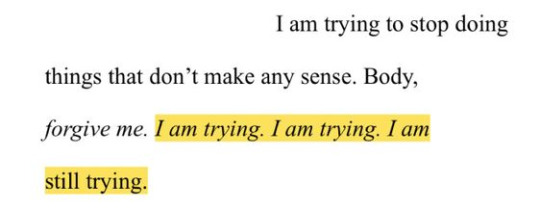
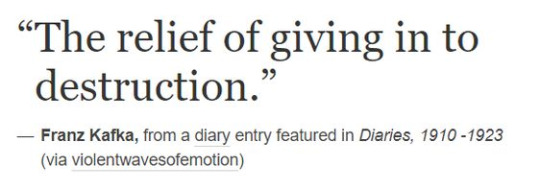


i hope you're doing okay <33
Miranda July It Chooses You / 藍月 Blue Moon (1997) dir. Ko I-Chen / pinterest / Franz Kafka Diaries, 1910-1923 / 青い春 Blue Spring (2002) dir. 豊田利晃 Toshiaki Toyoda / Heather Havrilesky Ask Polly: My Life Is Pathetic!
#trying to add more movie scenes into these#on self#on loneliness#on emotion#on sadness#web weave#web weaving#poetry compilation#poetry parallels#miranda july#it chooses you#blue moon movie#ko ichen#franz kafka#blue spring movie#toshiaki toyoda#heather havrilesky#ask polly#japanese movie#taiwanese movie#words#poem#spilled poetry#spilled thoughts#spilled ink#dark academia#writing#dark academia poetry#poetry#dark academia quote
224 notes
·
View notes
Text
On the way to breakfast today a random old guy wearing a bandana looked at me and loudly recited a line of Tang Dynasty poetry. I knew it was poetry because of his cadence, which also meant I was not going to be able to figure out the characters on my own, so I asked the brekkie shop boss lady if I could ask her a question only Taiwanese people would know. She was like 'oh! That's 明月松間照 by 王維! No, I don't know why he'd say that either.'
#if i see him again i could finish the line,which is 清泉石上流#although chances are he wouldn't remember the incident at all#there is some controversy as to how much classical Chinese should be taught in taiwanese public school#but in this case it's remarkably useful that tang poetry is common knowledge#good because i misheard zhào as sào or cào so i couldn't look it up by pinyin#i had to literally repeat it to someone before i forgot
16 notes
·
View notes
Text
Redd Reviews: OBIT by Victoria Chang

Genre: Poetry
Major Tropes: /
Representation: Written by a Taiwanese American woman in an autobiographical style.
My Thoughts
OBIT by Victoria Chang is largely a book about grief, over things lost and things remaining. Grief is an obsessive thing, and the book dwells on it obsessively, along with the obituary form that gives the collection its name. Most of the book takes the form of obituaries—a simple, rectangular form beginning with the name and death date of the thing that died. Occasional tonkas break up the monotony, but really the form never truly gets monotonous in the first place; as simple as it is, it is equally versatile.
I always thought the reader would get tired before the writer, but I didn’t with the obituary style. I believe this has a lot to do with the simplicity of language Chang uses—the reader never really needs a break from the form or from anything else because the brain is not working overhard. Instead, the heart is working, filled with the type of grief one feels for a stranger.
Chang painstakingly revisits each subject she writes about multiple times, which makes the chronology of the book quite interesting. Rather than pursuing the events chronologically, as I have in my poetry collections before, Chang invites the reader to be reminded over and over of her grief, the same way she likely was when she was living it. I questioned this choice at first but I really do think it recreates the waves of grief one feels for years and decades after trauma and loss. While I did feel the need to keep checking prior poems for dates, I feel like reading the poems in the order presented did mostly put me in the position of someone grieving for some time after an event.
As she revisits subjects, Chang also titles some poems the same. This concept intrigues me greatly. The poems are not distinguished by number or in any other way, the titles just repeat. This again makes the reader feel as though we are experiencing the same loss, over and over, enhancing the obsessive theme of the book.
Chang’s grief doesn’t only extend into her past, though. Many of the tonkas interspersed throughout begin with “I tell my children” or “My children, children”—they look to the future. It can be hard to look to the future when gorging on grief, and I find these poems to be a beautiful reminder for us to keep looking forward.
Some of the things we grieve with Chang aren’t people or even aspects of people. We mourn Chang’s mother’s chair, for oxygen, for voicemails and music. This, too, represents a reality of grief—we often don’t just grieve our father, but the specific brand of pens he used to carry and the sudokus he’d leave all around the house. The scent he used to wear. His favorite foods. These items and concepts all carry a tint of our loved ones, and so we must grieve them too.
Overall, I found OBIT to be weird, wonderful, and crushing, as well as inspiring.
Rating: 📰📰📰📰/5
#bookblr#poetry#book review#book rec#victoria chang#poetry book#butredd#taiwanese american poetry#chinese american poetry#this is also an edited essay so i hope it's okay lol#obit
1 note
·
View note
Text
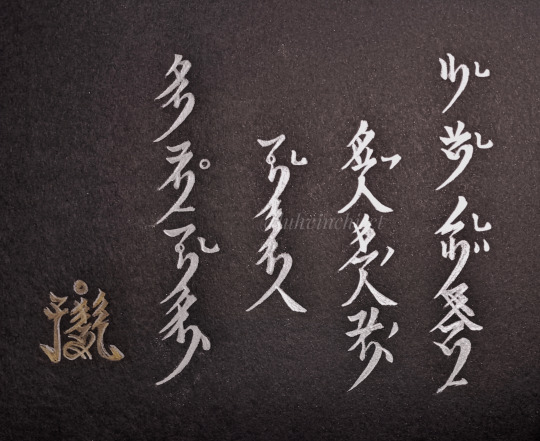
2023/09/16
Ū uē siūnn-beh tuì lí káng,
M̄-tsai thang ia̍h m̄-thang?
—— « Sù-kuì-âng », Lí Lîm-tshiu
——————————————
There's something I want to tell you,
I'm wondering if I could?
—— "Red in four seasons", Lí Lîm-tshiu
——————————————
有話想欲對你講,
毋知通抑毋通?
—— 《四季紅》,李臨秋
#台灣#handmade#taiwan#taigi#taiwanese#taiwanese artist#taiwanese language#language#calligraphie#calligraphy#handwriting#writting#taiwanese hokkien#台語#四季紅#李臨秋#鄧雨賢#verse#peoms#poetry#lyrics#taiwanese song#folklore
1 note
·
View note
Text
THE SADNESS:
Couple on the run
Disease makes people deranged
Escape a mad world
youtube
#the sadness#random richards#poem#haiku#poetry#haiku poem#poets on tumblr#haiku poetry#haiku form#poetic#haiku on tumblr#shudder#berant zhu#regina lei#ying ru Chen#Tzu chiang wang#rob jabbaz#horror#taiwanese film#extreme Asian#zombie#Youtube
0 notes
Text
Ghost Month Special: Heibai Wuchang
Today is the middle of Lunar Seventh Month, a.k.a. Zhongyuan Festival, and I feel like there can't be a more appropriate day to do a deep dive on my favorite ghost cops, a.k.a. the Black and White Impermanences, a.k.a. Seventh and Eighth Master, a.k.a. Tua Di Ya Pek, a.k.a. Xie Bi'an & Fan Wujiu.

Now, I've talked briefly about them in my Chinese Underworld post, and if you watch C-dramas or play certain Chinese games, you might have seen these two + learned a few things about them already. But for those who haven't, here's the five-minute summary:
-they are (one variant of ) Chinese psychopomps, who show up to take the souls of the deceased to the Underworld.
-they are also ghost cops, who go after troublesome ghosts that are disturbing the living.
-both wear tall hats with four characters on it (which also varied), as well as nearly identical black and white robes.
-for their Hokkien, Taiwanese and SEA versions, there's a significant height difference between the two; the white-robed one is tall and skinny, while the black-robed one is short and stout.
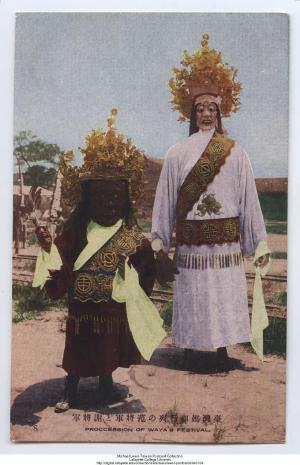
-the White Impermanence is often depicted with his tongue hanging out of his mouth (reminiscent of those who died by hanging) and a more cheerful expression, while the Black Impermanence is dark/blue-faced (reminiscent of death by drowning) and relatively more grim and fierce.
-the White Impermanence is also worshipped as a god of wealth by some.
However, outside of these bullet points, their tales and trajectory of development are a fascinating rabbit hole. I'd call them thorough folk gods, who evolved out of the greater existing character archetype of "ghost bureaucrats fetching people to the Underworld" and became their own unique characters almost entirely through folklore and oral legends.
So, without further ado, let's dive in.
Impermanence
The Great Spectre of Impermanence could arrive unexpectedly. (无常大鬼,不期而到)
——Sutra of Ksitigarbha's Fundamental Vows
To start talking about these two, we need to go into the general category of beings they separated out of later: Underworld officials.
Some conceptions of those petty ghost bureaucrats that mirrored living ones already existed in the Han dynasty; in burial goods and "grave scripts", there were paperwork dedicated to those officials, who were supposed to keep track of the Dead People Belongings List and maintain the segregation between the dead and the living.
Their characterization would get expanded a lot as time went on, in Northern-Southern dynasty and Tang legends, but this isn't an article about the ghost officials as a whole.
We are still tracing the origins of two specific ones, and to do that, we have to start with etymology——the "Wuchang" in their names.
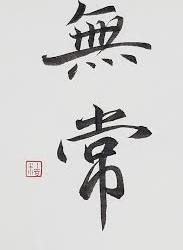
It is the translation of the Buddhist concept of "Anitya", referring to the impermanence of everything, which is always changing and dying and being reborn, with no constant to be found.
Yeah, you can see why a word describing the fleeting nature of life might eventually become associated with death and native psychopomps at some point in the Northern-Southern dynasty.
In the 39 chapter translation of the Dhammapada (interlaced with additional parables) by Fa Ju and Fa Li, the "Killing Spectre of Impermanence" (无常杀鬼) was first mentioned in the "On Impermanence" (无常品) chapter.
Another name for this grim-reaper-esque figure was "The Great Spectre of Impermanence", which appears in the quote at the beginning.
It appeared earlier than Ksitigarbha's Sutra, though: in another Northern-Southern dynasty translation of the Sutra of Golden Light, a Great Spectre of Impermanence was mentioned as this scary being that swallowed a king's younger son up whole.
By the Tang dynasty, the Spectre of Impermanence had appeared in both poetry and Buddhist text collections, as a generic name for the ghost that came to get you when you die.
However, the name wasn't exactly common or widespread, as made evident by all the N & S. dynasty and Tang legends about ghost bureaucrats where they were just referred to as, well, ghost bureaucrats.
Similarly, the Scripture on the Ten Kings doesn't mention anything about a Spectre of Impermanence. Instead, the second variant of the sutra says there are 3 ghosts working under King Yama——the "Soul-seizing Ghost" (夺魂鬼), "Essence-seizing Ghost" (夺精鬼), and "Spirit-binding Ghost" (缚魄鬼), responsible for dragging souls away in chains to the tree near the Underworld entrance pass.
(Their names might have corresponded to the idea of the Three Souls, each grabbing one of them, or the alternate division of Hun-Po plus the "vital force/essence".)
Right after that, however, they mentioned two demonic-looking birds sitting on the tree, one of which was named the "Bird of Impermanence", who would angrily scold and torment the dead for their misdeeds.
In this text, whatever the birds were, they were seen as a separate thing from the 3 ghosts that brought the souls of the dead to the Underworld entrance.
(A brief tangent about the 2 variants of the Ten Kings Scripture: the first could be found in the Dunhuang manuscripts, its name was 佛说预修十王生七经, and, as Teiser's translation of the scripture at the end of his academic book has showned, didn't have the 3 ghosts or the birds.)
(The variant mentioned above is 地藏菩萨发心因缘十王经, which is likely a Song dynasty Japanese apocrypha based on the first variant.)
Buddy Ghost Cops
When the ghostly officials of the Tang legends showed up, they could be alone, in pairs or in groups.
It was only in the Song-Yuan era that the idea of ghost cops showing up in pairs began to populate, and the first mention of the "Two Spectres of Impermanence" appeared in Vol. 3 of the Song dynasty 随隐漫录.
However, even without the word "Impermanence" attached, in various Song texts, the idea of there being 2 ghosts coming to get you instead of a single one or a group had already showed up with more frequency than before.
Come Ming dynasty, the Two Spectres of Impermanence got even more notable mentions in vernacular novels: a descriptive poem in Chapter 115 of Water Margins brings them up alongside the "Generals of the Five Paths" (五道将军), another native Underworld deity that showed up in Tang novels.
Plum in the Golden Vase, a.k.a. "that one Ming classic novel that often got censored and un-classic-ed because of its graphic sexual content", also has a folk Precious Scroll singing session (a story within a story, basically) that mentioned them.
In this story, King Yama sent a pair of "Impermanence Spectres" after Lady Huang, the protagonist of the scroll, who were also referred to as "Divine Boys/Acolytes of Good and Evil".
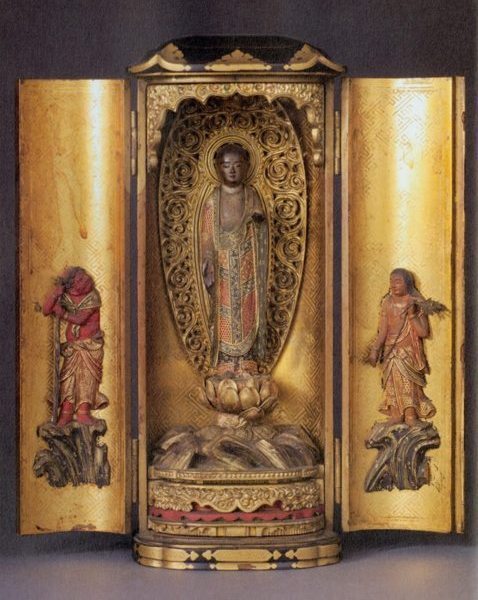
Now, the Boy-Acolytes of Good and Evil (善恶童子) were a pair of existing Underworld deities that had appeared in Dunhuang manuscripts and Ksitigarbha-themed artworks, responsible for recording the good and bad deeds of people respectively.
Their first mention was in the Tang translation of Surangama Sutra, and according to the second variant of the Ten Kings Scripture, the one recording bad deeds was said to look like a Raksha, while the one responsible for good deeds just looked like a regular divine acolyte.
Plum in the Golden Vase might have briefly aluded to that quirk too, in the story-within-a-story, where it was said that "Good people are welcomed by the acolyte(s), while bad people get the Yaksha(s)".
In the earlier Song dynasty compendium, Yijian Zhi, there are also mentions of two kids leading a fortunate guy's soul out of the Underworld, as well as showing up to inform some guy's wife that her days were numbered.
The second story is kinda funny, because after she had pretty much rolled over and accepted her fate, the two kids suddenly returned and were like "Excuse me, was Zhao your maiden name, or your husband's?"
Upon being informed that it was the latter case, they were like "Dangit, almost got the wrong person." Immediately after they left, another woman in the neighborhood whose surname was actually Zhao died.
Both stories do not use the specific name of "Acolytes of Good & Evil" for them, though, nor are they described as recorders of good and evil deeds.
For all I know, these two kids could be just like the pair of "young boys in blue robes" (青衣童子) who led Taizong into the Ghost Gate and the Underworld proper in JTTW Chapter 11: generic ghost workers.
But in Plum in the Golden Vase at least, they seemed to have been absorbed into the larger category of the Impermanence Ghosts, even though the Impermanence Ghosts still weren't their own characters yet, or gained any iconic uniforms.
Rather, it's more that 1) the catch-all name of "Impermanence" has become somewhat widespread for the generic ghost cops, though not yet universal, and 2) the Underworld apparently has a buddy-cop system in place now, where there had to be two ghostly officials for every newly dead person.
Psychopomp Outsourcing
In the late Ming and Qing dynasty, we got another twist on the Wuchang thing: Zou Wuchang, literally "Walk as Impermanences".
I've talked before about the early version of Taizong's trip to the Underworld, where Cui Jue/Ziyu, instead of being posthumously made a ghost judge, was a living official working part-time for the Underworld.
Well, Zou Wuchang is similar, but less prestigious, and you don't get paid either. The Underworld is short of hands (somehow), so they just grab a random living person and be like "Go fetch dead people for us."
The earliest mention of such a tradition in the Ming dynasty 语怪 placed the custom in Fengdu, the famous "ghost city" of Sichuan.
According to the text, when someone's soul was yanked off its streets to work as part-time psychopomps, they just fainted on the spot, and would revive after a few hours or overnight. The phenomenon was so common, the locals weren't even shocked, nor bothered getting them any medical attention.
Yuewei Caotang Biji goes further into the rationales of why Underworld needed those living conscripts. Apparently, all the living people clustered around a sickbed created a blazing aura of Yang, which certain venerable/fierce/brutish individuals also possessed in abundance, and was anathema to the ghost cops.
They were beings of pure Yin, after all, while the conscripts, whose bodies were Yin but still had plenty of Yang-aligned Qi, didn't have to worry about that.
Zou Wuchang was also not gender-exclusive, and there were mentions of multiple female conscripts in Qing legend compendiums.
Also, though the recruitment was forceful, you could actually retire after serving for a number of years——in one tale from 庸闲斋笔记, a woman fought the conscript for her mother-in-law's soul, who took pity on her and reported back to the City God.
In response, the City God said he'd send a report to Yama to see if she could be spared, and also released the conscript from her duty on account of her kind heart.
The popularity of this tradition across multiple sources and a long stretch of time signalled that, to an even greater extent than before, the ghost cops weren't generic ghost cops no longer: they are The Impermanences, which is only a few step away from developing into their own characters with unique iconography.
Black and White
First: where did their signature robe colors come from?
According to the first variant of the Ten Kings Scripture, officials under the Ten Kings were supposed to be dressed in black robes, riding a black horse, and carrying a black banner.

But in Tang folklore compendiums, that dress code wasn't a thing at all. A Taiwanese paper actually goes through tales of ghost officials inside Taiping Guangji where their appearances were described, and counted 22 cases of them wearing yellow robes, 7 cases of red robes, and only 8 stories involving ghost officials in either black or white robes.
Though ghost officials in black as well as white robes never appeared in the same story, they did have two things in common: 1) they tended to be quite tall, and 2) almost half of them were carrying weapons of some sorts.
The very late Ming/early Qing novel, Cu Hulu, also has a character ask Bodhisattva Ksitigarbha a bunch of questions in Chapter 12.
One of them was about the discrepancy between the depiction of Underworld officials in temples and the ones he personally saw, and he mentioned that the statues of "Impermanences" were 1) dressed in mourning robes and 2) about a Zhang and two Chi (3+ meter) in height.

Which suggests that, by the novel's time, the ghost cops had already gained a set of uniforms, one associated with funerary affairs.
(Also: I love Ksitigarbha's answer to that particular question——"Yeah we used to have a really tall ghost cop like that, people just call him 'Wuchang' because they don't know what the heck he is. Also, Impermanence isn't actually a real name, it's a concept.")
However, as far as I know, the earliest mention of a pair of ghost cops, one in white and one in black, was in Vol. 19 of Yuewei Caotang Biji. And the story is quite funny.
Basically, this Sun guy was temporarily residing in someone else's house, and the host's mother was severely ill. One day, the family servant boy carried in some dinner for him, and because Sun was busy with something else, he told the boy to put it on a nearby table in another room.
Suddenly, a white robed guy just appeared out of nowhere and entered the house, followed by a short black robed guy.
Sun hurried into the room, saw the two guys stealing his dinner, and angrily yelled at them. The white robed guy noped out of there, leaving the black robed guy behind and hiding in a corner, unable to exit the room because Sun was blocking the door.
He kinda just sat outside and kept an eye on them for a while, before the host of the family suddenly showed up, telling him that his mother had just spoken.
Basically, the ghost officials had come for her, and one of them happened to be cornered in the room by Sun, so would he please move? She didn't want to be punished for showing up late.
The host didn't know if it was true either, and was just going out there and checking. But the moment Sun went and sat somewhere else, the ghost in black scampered out of the room. Soon afterwards, wailing began to come out of the mother's room, suggesting she had been taken away.
As hilariously pathetic as these two unnamed ghost cops are, the only thing connecting them to the Heibai Wuchang of much later times is their robe colors, and the black-robed one being short.
There are no tales featuring both 1) a pair of ghost cops in black and white, and 2) the pair being referred to as "Impermanences", though.
The middle-late Qing stories that do refer to the ghost cops as such tend to only feature a single Impermanence: unnaturally tall, dressed in white robes and hats, either holding a fan or carrying strings of paper money on his shoulders, sometimes bleeding from his eyes or nose/mouth.

(Yep, you know how the White Impermanence is often seen as the older of the two sworn brothers? As far as their historical existence goes, he really is the older guy.)
It was in the 19th century 醉茶志怪 that we saw the first signs of the two converging. In the three stories with "Impermanence" in their titles, two featured the "white-robed ghost cop in tall hat" alone, one of which described him as looking like a 10+ years old kid, standing at the side of the road like a temple clay statue.
The third story, however, featured a sighting of two giant ghosts, one in white and one in blue/green, near the City God's temple. Out of the four people involved in the encounter, three died after a few days, and the only survivor was the one who had his line of sight blocked by the palaquin.
How did 1 become 2?
How did the single unique Impermanence become the Black and White Impermanences?
Well…it's a complicated question with no definitive answers. We know that in the (probably Qing dynasty) Jade Records, there are already mentions of a pair of ghosts called Huo Wuchang ("Life-is-Impermanent" or "Living Impermanence") and Si Youfen ("Death-Has-a-Part").
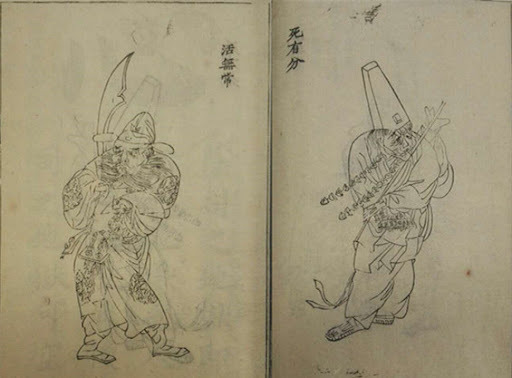
The former wears a black official hat and formal robes, holds brushes and papers in his hands, with blades on his shoulders and torture tools on his belts. He has big bulging eyes and is often laughing.
The latter has dirty, bloodied face, wears a white robe, holds an abacus, carries a sack of rice on his shoulder and has paper money dangling in front of his chest like a necklace. He has a sad frown on his face and is always sighing.
As you can see, there are similarities, but also notable differences from the "iconic" Black & White Impermanences. Whereas the White Impermanence is usually depicted as the cheerful one in white robes, carrying an abacus and wearing strings of paper money, here, he is the sad and grim one.
Their jobs also differ: instead of fetching souls to the Underworld, in the Jade Records, these two are responsible for pushing the dead off the bridges after they have drunken Mengpo's amnesia soup, into the scarlet river so they can reincarnate.
Personally, I view them as a transistory stage between the "Generic Impermanence Ghosts" and "The Two Unique Psychopomps We Know and Love", one strand of the folk god evolutionary process that was captured in written sources.
A Japanese paper goes into another strand in the evolution: the addition of the Black Impermanence. Namely, he might have grown out of a ghost that commonly showed up in City God worship and parades, the so-called "Wall-touching Ghost" (摸壁鬼).
The claim was based on very late Qing newspaper illustrations, where the Black Impermanence was depicted as holding up his two arms like this:
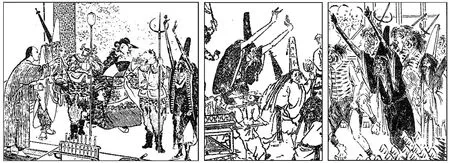
Which was a gesture commonly used by the "Wall-touching Ghost" during parades in the Jiangsu area, who also wore black robes and tall hats.
The author of the paper then dug into sources about the Wall-touching Ghost, and not only found records of the parades, but also a Qianlong era Mulian opera script, 劝善金科, that paired him together with the Impermanence Ghost as fetchers of the dead.

(The two were also given names in this opera: the Impermanence Ghost is named Ba Yang, and the Wall-touching Ghost, Wu Qi.)
Earlier mentions of the Wall-touching Ghost in Qing folklore compendiums, however, didn't depict him as a ghost cop. The story in 夜航船 just described it as a ghost thing that hid between walls and used its chill breath to suck up people's souls.
Another story in the 1878 浇愁集, even though it described the ghost more——dark-faced, holding its arms up like in the drawing, could turn into a cloud of black smoke and disappear into walls——still had it as your typical "ghost shows up, people die" ill omen.
So the paper's proposition is that, after the White Impermanence has separated out of the "Generic Ghost Cop Impermanences" and become his own thing, people in southern Jiangsu built on their existing Wall-touching Ghost and made him into the former's partner, absorbing most of his iconography in the process.
Similarly, the "tall and short" pair-up that was popular in Fujian and spread across Taiwan and SEA might also be a result of parallel local evolution, together with the name Xie Bi'an and Fan Wujiu.
Xie and Fan
Yes! At last, at last, we are getting to the most well-known and popular origin story, a.k.a. the Nantai Bridge Tale.
A summary: Xie Bi'an and Fan Wujiu were a pair of best friends/sworn brothers from Fujian, working as constables for the local magistrate. One day, while they were out on a mission, they saw a storm brewing. Xie went back to grab umbrellas while Fan waited for him under the bridge.
Unfortunately, the downpour soon began, causing the river to flood. Fan, unwilling to break his promise, continued waiting for Xie under the bridge and drowned. When Xie returned and saw his sworn brother's corpse, he hang himself out of guilt and grief too.
(…As a casual reader, I, always wondered why "waiting ON the bridge instead of under it" never crossed his mind as an option. Okay, sure, it was raining. But that's all the more reason to not stand under the darn bridge.)
Touched by their loyalty to each other, the City God/King Yama/Jade Emperor appoints them as ghostly constables, responsible for fetching the dead to the Underworld.
This story bears a lot of similarity to the fable of Wei Sheng in Zhuangzi. Basically, the guy made a promise to meet a girl under a bridge, the girl didn't show up, there was a flood, and, unwilling to leave, he drowned while still clinging to the bridge pillar.
Zhuangzi's opinion of the guy wasn't too high, because honestly, what a stupid way to die.
However, Sima Qian held him up as an exemplar of loyalty and keeping one's word, and the reading stuck. For later folktales about Wei Sheng as well as others that adopted the basic premise, like one tale in the 七世夫妻 story cycle, it also tended to get turned into a straight-up love story.
Though the Nantai Bridge Tale is the most popular version of their backstory, it's far from the only version. One version has them as Tang dynasty officials, working under the historical figure Zhang Xun, who died during the Anshi Rebellion.
While they were trying to get reinforcements, Xie was caught and hung on the city gate by the rebels, while Fan accidentally drowned.
When Zhang Xun was made a City God after the city fell and the rebels killed him, these two also became deified as his attendants.
In another version, Xie was a filial son with an aging mother, who had been wrongly imprisoned because of a friend's crime. During the Lunar New Year, Fan found him crying in the cell, and, upon learning about his sad backstory, released him secretly to visit his mother, on the condition that he returns after seven days.
However, his mother died soon after his return. Busy with her funeral, Xie did not return in time, and Fan, unable to answer to his superiors, committed suicide via drinking poison. When Xie returned and learned of the terrible news, he, too, hang himself.
And these three are far from the only known versions! Like, seriously, there are probably as many variations of the story as there are variations of the objects they held in their hands.
Though some elements stay more constant——using their deaths to explain their iconography, Xie being more commonly associated with the fan, umbrella, and abacus and Fan, chains, everything is subjected to changes and regional differences.
(For example, SEA oral legends tend to associate them with opium. Most of the time, they are constables or mercenaries employed to track down opium smugglers and other criminals, but some have them as Robin Hood-esque opium smugglers.)
Anyways, I hope this long post has offered some insight into the two iconic, yet also somewhat obscure ghost cops. I might add an "Appendix of Fun Facts and Tales" that doesn't fit into the main body of the post, but for now? That will be all.
May the readers who celebrate it have a nice Zhongyuan Festival.
Bibliography:
蔺坤:《无常鬼考源》
大谷亨:《黑无常的诞生与演变—— 以江苏南部的摸壁鬼传说为中心》
陈威伯、施静宜:《七爷八爷成神故事研究》
江義雄:《臺灣「黑白無常」與「范謝將軍」研究》
吳彥鋒:《臺灣七爺八爺傳說及其與信仰關係研究》
中国国家博物馆藏《十一面观音变相》的阐释
劉榕峻:狂放不羈、怪異獨特:談香港藝術館展出的「揚州八怪」
Stephen F. Teiser, The Scripture on the Ten Kings and the Making of Purgatory in Medieval Chinese Buddhism
Fabian Graham, Voices from the Underworld: Chinese Hell Deity Worship in Contemporary Singapore and Malaysia
CBETA: 《地藏王菩萨本愿经》
CBETA:《佛说地藏王菩萨发心因缘十王经》
夷坚志/支癸07,“赵彥珍妻”
《金瓶梅词话》,Chapter 74
《醋葫芦》,Chapter 12
《劝善金科》Vol.5, Part 2
The Jade Guidebook: Appendices, translated by David K. Jordan
Journey to the West Vol.1, Chapter 11, translated by Anthony C. Yu
#chinese folklore#heibai wuchang#fan wujiu#xie bi'an#chinese folk religion#chinese underworld#cw: death#cw: suicide#hell#ghosts#ghost month#hungry ghost festival
131 notes
·
View notes
Text
[Book Rec + Reaction/Thoughts] The Lantern and the Night Moths 灯与夜蛾 by Yilin Wang
An anthology of translated poems by five modern or contemporary poets and accompanying essays by the translator, @yilinwriter.
You can find the pronunciation guide and list of corrections here!
The cover art, a beautiful expression of the tone of this collection, is by Taiwanese artist Ciaoyin (check out her gorgeous insta!). I'm looking forward to the arrival of the physical book as my tab absolutely does not do it justice xD

Anyway! The official release date is 02 April 2024 though there have been some very thoughtful reviews by early readers already. Here, here, here and here.
(It was an ARC that I received too… though in the time it took to put this together, the ebooks have already gone out to readers >.< typical snail yj!)
Instead, I’ll tell you who I think would be interested in this book or might benefit from reading it, then share things that are cool about it from the perspective of a bilingual hobbyist translator + lover of ancient poetry and lyrics.
Who should read it?
If annotations, translator’s notes and reflections spark joy for you...
If you’ve ever read poetry translations and been intensely curious about what goes on under the hood...
If you’re a translator yourself wanting to hear another voice...
Definitely check this out!
Also if you’re CN+EN bilingual and have ever read something in English that references Chinese terms and concepts etc. except ONLY in English, pinyin or wade-giles and been utterly frustrated by the ensuing guessing game (like me) Fear Not.
That will not be a problem here.
I really appreciate how Chinese words are used naturally where needed for concepts and quotes - they are also translated for those who can't read Chinese so no one is left out. It made this book of and about translation (and more) super comfortable to read! The solution is so simple, so direct, so rarely used that I am amused.
Oh, but do note that the Chinese characters are in simplified though!
The poems are organised by their writers who are listed here by order of birth year, not appearance in the book:
秋瑾 (Qiu Jin, 1875 to 1907)
废名 (Fei Ming. 1901 to 1967)
戴望舒 (Dai Wangshu, 1905 to 1950)
小西 (Xiao Xi, 1974 to _)
张巧慧 (Zhang Qiaohui, 1978 to _)
Altogether, that covers nearly the last 150 years up to now. I’ve never really been into poetry by poets in such relatively recent times, in part because I’d been holding on to this stereotype of them spurning Classical Chinese and ancient poetry in the first half of the 20th century (not entirely true, as I came to realise xD). It made sense and was understandable, but felt sad.
Yet am I the target audience for this book?
Very much so.
In ways I didn’t think I would be too! It was so much fun to experience this both as a reader and a translator that I thought I’d share it here, where we are appreciating Chinese poetry together.
If you didn’t think you’d enjoy modern Chinese poetry, hey, give it a chance!
Oh yeah - on the way home a while back, I was talking to a friend about translation and was surprised to hear that her impression was that it ought to be a straightforward process. Like isn’t it a 1:1 conversion? At some point, ‘what’s the difference between something google translate might return, and how you would say it?’ was asked, and oh that was a delightful question to my ears! I showed her one of my comparison sheets where an original text is laid out alongside multiple translations line-by-line, briefly explaining some common and unique choices and how the people who had translated those probably arrived at the various interpretations. She was pretty amazed to see that the answer to her question was: very different. Hey, it’s a complicated process!
But there’s only so much one can explain in the space of a train ride. That’s why The Lantern and the Night Moths is a book I would also rec to someone like this friend of mine - open minded and curious but never having the chance to think about or encounter the craft of translation.
Like Yilin says, ‘the meaning of a word cannot be fully expressed in one single translation, nor through a series of translation attempts’. She then explains why with great attention to detail and some solid examples from one of the poems with word choices loaded with subtle connotations :D
What's interesting about it?
Okay, for one, Yilin shared a playlist of music that she listened to while working on this book. Here is the link to the spotify one and the one on youtube. Check them out! They sure put me in the mood to read xD (favs: 别知己, 小神仙 & 去有風的地方) Afterwards, this made so much sense like - ah! an audio moodboard.
She's also putting together these adorable mini profiles of each poet along with a cmedia and tea rec to match their vibes. Go see them on her instagram xD
Now to business...
structure
What really helped keep the reader’s focus was the way each section is organized, how the poems and accompanying essay were presented and finally the short bio of each person right at the end.
The poets are first introduced through five or six of their poems, works well suited to this purpose. Their voices, distinct through the vision, ambition and emotion of their words, are brought across by Yilin’s sensitive, thoughtful and poetic translations into English. These translations were also creative and transformative in a way that made so much sense after reading one of her reflections on the process, how she ‘must guide it with gentle hands to ensure its spirit is kept alive and intact during this transformative, and often excruciating process’. A rebirth into another language!
Personally, I’ve come to think of reading translations as looking at a work through another’s eyes. So it’s delightful when the translator’s presence is discernible, and even more so when the reader is given insight into their intention and process via commentary.
Yilin’s essays coupled with the poets’ bios at the end provide a means to go back and appreciate their works in context of their circumstance and inspirations. Similarly, to read the translations with a changed perspective.
I don’t know how much of a thing this is with translated poetry anthologies in English - can count the number I’ve read with both hands lol, and they’re all of the ancient chinese poetry variety - but I really like this design.
drawing on poets who came before them
Remember how we’re always recognizing traces of inspiration from ancient works (to them) in poetry of the various dynasties? 李商隐 Li Shangyin of Tang for example, was influenced by 楚辞 Verses of Chu and folklore and mythology such as that in 山海经 Classic of Mountains and Seas, 李白 Li Bai frequently references poets and history of the 魏晋 Wei-Jin era, and 王维 Wang Wei was clearly familiar with Buddhist scriptures which were translations themselves!
Just like the late Táng poets whom he praised for boldly deviating from the voices before them, Fei Ming used popular references and tropey shorthands ‘in contexts utterly different from the original, reimagining them anew’. Dai Wangshu, too, ‘boldly re-envisioned what modern poetry could look like by revisiting the classics’. In fact, in his very relatable ‘To Answer the Visitor with Classical Imagery’, I see Li Bai’s 春夜宴桃李园序, Qu Yuan’s 离骚 and lots of - as the title says - classical imagery, as if pulling out painting after painting to describe a feeling.
And Dai Wangshu’s faith in the translatability of poetry, that ‘poetry isn’t what is lost in translation, but rather, what survives it’ reminds me of what a friend, @xiakeponz, said that I agree with so much - because readers can ‘experience something in their own individual way through (your) shared humanity rather than language alone’.
poetic tradition and beyond
Between the lines of contemporary poets Zhang Qiaohui and Xiao Xi, I can really see the charm of plain vernacular, how it can be beautiful, incisive and clever in turns. Even as it seems to have moved further than ever from the structure and language of literary Chinese, the themes that inspired common motifs remain a part of life. Mother and divinity, homesickness, finding oneself, tributes to admirable spirits and the issues that trouble society - just in a new form and with different ways of expression.
Qiu Jin
So many FEELINGS about what Qiu Jin was doing - ‘I awaken the spirits of women, hundreds of flowers, abloom’. I would love if she could see the world now. So many things for her to rouse and fight against, but at the same time just as many to be proud of. I am so in awe of her, but now hearing her loneliness and struggle there is a soft spot in my heart for those too.
conclusion
So so so…
Qiu Jin’s admirable fire and lonely resolve. Zhang Qiaohui’s precious ability to express beauty in the mundane and in pain. Fei Ming’s utter delight! He is having so much fun and when* I’m vibing, I feel it too. Xiao Xi’s critical eye and keen observation of the world. Dai Wangshu’s whimsical charm and passion for translation. Finally, Yilin Wang, the connecting thread wound through them all, bringing them together so that we may be acquainted.
*Reading his poetry is like unwrapping a seamless, many layered present. A gift that keeps giving - if only you have a key 😅 Fortunately, Yilin has halved our struggle 🤣
I’ve had such a great time with them all. And if you come, I hope you will too!
#The Lantern and the Night Moths#chinese poetry#Yilin Wang#poetry in translation#灯与夜蛾#Qiu Jin#Zhang Qiaohui#Fei Ming#Xiao Xi#Dai Wangshu#rambly reviews#i read from Fei Ming onwards on my kobo LOL but that one has no colour so...#i might do more of these review-y rambles about poetry things if y'all are interested?#i've been reading LOL#some are chinese some are english#all of them fun and enlightening
40 notes
·
View notes
Text
Queer Calendar 2023
We put together a calendar of key (mostly queer) dates at the start of the year to help us with scheduling - so I thought I’d share it around! Including pride and visibility days, some queer birthdays and anniversaries, and a few other bits and bobs. Click the links for more info - I dream one day of having a queer story for every day of the year!
This is obviously not an exhaustive list - if I’ve overlooked something important to you, feel free to add it in the reblogs!
January
3 - Bisexual American jazz-age heiress Henrietta Bingham born 1901
8 - Queer Australian bushranger Captain Moonlite born 1845; gay American art collector Ned Warren born 1860
11 - Pennsylvania celebrates Rosetta Tharpe Day in honour of bisexual musician Rosetta Tharpe
12 - Japanese lesbian author Nobuko Yoshiya born 1896
22 - Lunar New Year (Year of the Rabbit)
24 - Roman emperor Hadrian, famous for his relationship with Antinous, born 76CE; gay Prussian King Frederick the Great born 1712
27 - International Holocaust Remembrance Day
February
LGBT+ History Month (UK, Hungary)
Black History Month (USA and Canada)
1 - Feast of St Brigid, a saint especially important to Irish queer women
5 - Operation Soap, a police raid on gay bathhouses in Toronto, Canada, spurs massive protests, 1981
7 - National Black HIV/AIDS Awareness Day (USA)
18 - US Black lesbian writer and activist Audre Lorde born 1934
12 - National Freedom to Marry Day (USA)
19-25 - Aromantic Spectrum Awareness Week
March
Women’s History Month
1 - Black Women in Jazz and the Arts Day
8 - International Women’s Day
9 - Bi British writer David Garnett born 1892
12 - Bi Polish-Russian ballet dancer Vaslav Nijinsky born 1889 or 1890
13 March-15 April - Deaf History Month
14 - American lesbian bookseller and publisher Sylvia Beach born 1887
16 - French lesbian artist Rosa Bonheur born 1822
20 - Bi US musician Rosetta Tharpe born 1915
21 - World Poetry Day
24 - The Wachowski sisters’ cyberpunk trans allegory The Matrix premiers 1999
April
Jazz Appreciation Month
Black Women’s History Month
National Poetry Month (USA)
3 - British lesbian diarist Anne Lister born 1791
8 - Trans British racing driver and fighter pilot Roberta Cowell born 1918
9 - Bi Australia poet Lesbia Harford born 1891; Easter Sunday
10 - National Youth HIV & AIDS Awareness Day (USA)
14 - Day of Silence
15 - Queer Norwegian photographer and suffragist Marie Høeg born 1866
17 - Costa-Rican-Mexican lesbian singer Chavela Vargas born 1919
21-22 - Eid al-Fitr
25 - Gay English King Edward II born 1284
26 - Lesbian Day of Visibility; bi American blues singer Ma Rainey born 1886
29 - International Dance Day
30 - International Jazz Day
May
1 - Trans British doctor and Buddhist monk Michael Dillon born 1915
7 - International Family Equality Day
7 - Gay Russian composer Pyotr Tchaikovsky born 1840
15 - Australian drag road-trip comedy The Adventures of Priscilla, Queen of the Desert premiers in 1994
17 - IDAHOBIT (International Day Against Homophobia, Biphobia, Intersexism and Transphobia)
18 - International Museum Day
19 - Agender Pride Day
22 - US lesbian tailor and poet Charity Bryant born 1777
22 - Harvey Milk Day marks the birth of gay US politician Harvey Milk 1930
23 - Premier of Pride, telling the story of the 1980s British activist group Lesbians and Gays Support the Miners
24 - Pansexual and Panromantic Awareness and Visibility Day; Queer Chinese-Japanese spy Kawashima Yoshiko born 1907
26 - queer American astronaut Sally Ride born 1951
29 - Taiwanese lesbian writer Qiu Miaojin born 1969
June
Pride Month
Indigenous History Month (Canada)
3 - Bisexual American-French performer, activist and WWII spy Josephine Baker born 1906
5 - Queer Spanish playwright and poet Federico García Lorca born 1898; bi English economic John Maynard Keynes born 1883
8 - Mechanic and founder of Australia’s first all-female garage, Alice Anderson, born 1897
10 - Bisexual Israeli poet Yona Wallach born 1944
12 - Pulse Night of Remembrance, commemorating the 2012 shooting at the Pulse nightclub, Orlando
14 - Australian activists found the Gay and Lesbian Kingdom of the Coral Sea Islands in 2004
18 - Sally Ride becomes the first know queer woman in space
24 - The first Sydney Mardi Gras 1978
25 - The rainbow flag first flown as a queer symbol in 1978
28 - Stonewall Riots, 1969
28 June-2 July - Eid al-Adha
30 - Gay German-Israeli activist, WWII resistance member and Holocaust survivor Gad Beck born 1923
July
1 - Gay Dutch WWII resistance fighter Willem Arondeus killed - his last words were “Tell the people homosexuals are no cowards”
2-9 - NAIDOC Week (Australia) celebrating Aboriginal and Torres Strait Islander culture
6 - Bi Mexican artist Frida Kahlo born 1907
12 or 13 - Roman emperor Julius Caesar born c.100BCE
14 - International Non-Binary People’s Day
23 - Shelly Bauman, owner of Seattle gay club Shelly’s Leg, born 1947; American lesbian cetenarian Ruth Ellis born 1899; gay American professor, tattooist and sex researcher Sam Steward born 1909
25 - Italian-Australian trans man Harry Crawford born 1875
August
8 - International Cat Day
9 - Queer Finnish artist, author and creator of Moomins Tove Jansson born 1914
9 - International Day of the World's Indigenous Peoples
11 - Russian lesbian poet Sofya Parnok born 1885
12 - Queer American blues musician Gladys Bentley born 1907
13 - International Left-Handers Day
22 - Gay WWII Dutch resistance fight Willem Arondeus born 1894
24 - Trans American drag queen and activist Marsha P Johnson born 1945
26 - National Dog Day
30 - Bi British author Mary Shelley 1797
31 - Wear it Purple Day (Australia - queer youth awareness)
September
5 - Frontman of Queen Freddie Mercury born 1946
6 - Trans Scottish doctor and farmer Ewan Forbes born 1912
13 - 1990 documentary on New York’s ball culture Paris is Burning premiers
15-17 - Rosh Hashanah
16-23 - Bisexual Awareness Week
17 - Gay Prussian-American Inspector General of the US Army Baron von Steuben born 1730
23 - Celebrate Bisexuality Day
24 - Gay Australian artist William Dobell born 1889
30 - International Podcast Day
October
Black History Month (Europe)
4 - World Animal Day
5 - National Poetry Day (UK)
5 - Queer French diplomat and spy the Chevalière d’Éon born 1728
8 - International Lesbian Day
9 - Indigenous Peoples’ Day (USA)
11 - National Coming Out Day
16 - Irish writer Oscar Wilde born 1854
18 - International Pronouns Day
22-28 - Asexual Awareness Week
26 - Intersex Awareness Day
31 - American lesbian tailor Sylvia Drake born 1784
November
8 - Intersex Day of Remembrance
12 - Diwali; Queer Mexican nun Sor Juana Inés de la Cruz born c.1648
13-19 - Transgender Awareness Week
20 - Trans American writer, lawyer, activist and priest Pauli Murray born 1910; Transgender Day of Remembrance
27 - Antinous, lover of the Roman emperor Hadrian, born c.111; German lesbian drama Mädchen in Uniform premiers, 1931
29 - Queer American writer Louisa May Alcott born 1832
December
AIDS Awareness Month
1 - World AIDS Day
2 - International Day for the Abolition of Slavery
3 - International Day of Persons with Disabilities
8 - Pansexual Pride Day; queer Swedish monarch Christina of Sweden born 1626
10 - Lesbians and Gays Support the Miners host Pits and Perverts concern to raise mining for striking Welsh miners, 1984
14 - World Monkey Day
15 - Roman emperor Nero born 37CE
24 - American drag king and bouncer Stormé DeLarverie born 1920
25 - Christmas
29 - Trans American jazz musician Billy Tipton born 1914
#calendar#queer calendar#queer observances#pride days#queer history#lgbt#lgbtq#lgbt history#gay history#trans history#queer#gay#trans#lesbian#lesbian history
256 notes
·
View notes
Text
My life's plans right now are to read poetry, listen to taiwanese indie rock and bake banana bread
33 notes
·
View notes
Text
我愛的人會老
我的愛會老
我的老
是愛我的人
送我的
──莊東橋〈我愛的人會老〉
我的愛會老。
0 notes
Text
about : ashterie !
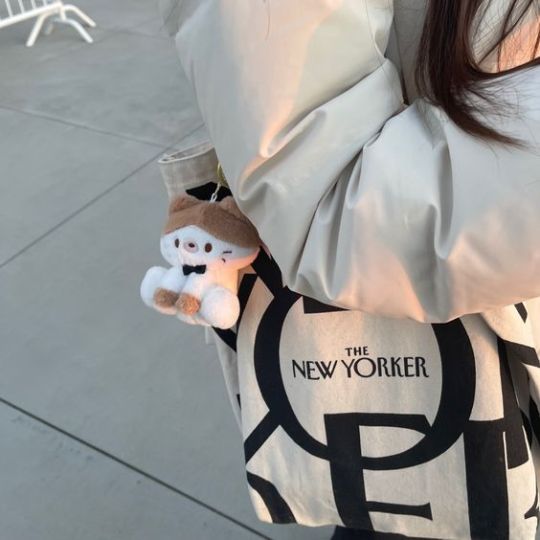



ash — she/her — infj 4w3
minor — taiwanese — pst
hello, welcome to my page! thank you for stopping by :)
this is an enha-centric blog, but i'm also a fan + listener of many other groups. other than kpop, i also live laugh love beabadoobee, wave to earth, laufey, sundial, & jenny nuo!
this blog will be kept safe for work as i am a minor. please send me dms, asks, or recs anytime— i love hearing from you all <33
groups + bias(es) rolecall:
enhypen — jungwon & sunoo
boynextdoor — jaehyun
le sserafim — yunjin
tomorrow x together — taehyun
zerobaseone — zhanghao
newjeans — minji & hanni
illit — iroha
hmu anytime about any of these topics too:
the us college admissions system
the academic weapon -> academic victim pipeline
ap physics, bio, chem (enha is still my main extracurricular but i am a stem girlie second)
orchestra, piano, music theory
high school journalism
poetry, books, pretty prose in general
anything mbti or personality type related
sunoo's absolutely insane duality
how jungwon is the most boyfriend to ever boyfriend
+ anything, really! <3
16 notes
·
View notes
Note
Hello. An absolute fan of absolutely amazing blog here 🙌. So recently I read your review of I Cannot Reach You. I came to a phrase you used "JBL tropes" that includes hand holding and kabedon. I may have also spotted you mentioning tropes in other posts as well. So I want to request you to write a post on tropes used Thai, Korean, Japanese, Taiwanese and more BLs please. Or if you already have written about this please guide me to it as I may have missed it.
Thanks again for your amazing work.
BL Tropes Meta
Oh ah. This used to be mainly a tracking the tropes blog. But a combination of me getting more meta, there being an overabundance of BL produced and tumblr's backend code getting increasingly buggy means I stopped trackign thme. But I have A LOT on tropes.
But this will likely give you the basics you're looking for:
The above is frozen and can no longer be updated but still fun.
Here's more that are just silly:
9 notes
·
View notes